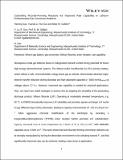| dc.contributor.author | Gao, Haining | |
| dc.contributor.author | Li, Yuanda | |
| dc.contributor.author | Guo, Rui | |
| dc.contributor.author | Gallant, Betar M. (Betar Maurkah) | |
| dc.date.accessioned | 2020-09-30T16:44:34Z | |
| dc.date.available | 2020-09-30T16:44:34Z | |
| dc.date.issued | 2019-04 | |
| dc.identifier.issn | 1614-6840 | |
| dc.identifier.uri | https://hdl.handle.net/1721.1/127778 | |
| dc.description.abstract | Nonaqueous metal–gas batteries based on halogenated reactants exhibit strong potential for future high-energy electrochemical systems. The lithium–sulfur hexafluoride (Li–SF6) primary battery, which utilizes a safe, noncombustible, energy-dense gas as cathode, demonstrates attractive eight-electron transfer reduction during discharge and high attainable capacities (>3000 mAh g−1carbon) at voltages above 2.2 VLi. However, improved rate capability is needed for practical applications. Here, two viable strategies are reported to achieve this by targeting the solubility of the passivating discharge product, lithium fluoride (LiF). Operating at moderately elevated temperatures, e.g., 50 °C, in DMSO dramatically improves LiF solubility and promotes sparser and larger LiF nuclei on gas diffusion layer electrodes, leading to capacity improvements of ≈10× at 120 µA cm−2. More aggressive chemical modification of the electrolyte by including a tris(pentafluorophenyl)borane anion receptor further promotes LiF solubilization; capacity increases even at room temperature by a factor of 25 at 120 µA cm−2, with attainable capacities up to 3 mAh cm−2. This work shows that bulk fluoride-forming conversion reactions can be strongly manipulated by tuning the electrolyte environment to be solvating toward F−, and that significantly improved rates can be achieved, leading a step closer to practical applications. | en_US |
| dc.description.sponsorship | National Science Foundation (U.S.) (Award DMR-14-19807) | en_US |
| dc.language.iso | en | |
| dc.publisher | Wiley | en_US |
| dc.relation.isversionof | 10.1002/AENM.201900393 | en_US |
| dc.rights | Creative Commons Attribution-Noncommercial-Share Alike | en_US |
| dc.rights.uri | http://creativecommons.org/licenses/by-nc-sa/4.0/ | en_US |
| dc.source | Prof. Gallant via Elizabeth Soergel | en_US |
| dc.title | Controlling Fluoride‐Forming Reactions for Improved Rate Capability in Lithium‐Perfluorinated Gas Conversion Batteries | en_US |
| dc.type | Article | en_US |
| dc.identifier.citation | Gao, Haining et al. “Controlling Fluoride‐Forming Reactions for Improved Rate Capability in Lithium‐Perfluorinated Gas Conversion Batteries.” Advanced Energy Materials, 9, 21 (April 2019): 1900393 © 2019 The Author(s) | en_US |
| dc.contributor.department | Massachusetts Institute of Technology. Department of Mechanical Engineering | en_US |
| dc.contributor.department | Massachusetts Institute of Technology. Department of Materials Science and Engineering | en_US |
| dc.relation.journal | Advanced Energy Materials | en_US |
| dc.eprint.version | Author's final manuscript | en_US |
| dc.type.uri | http://purl.org/eprint/type/JournalArticle | en_US |
| eprint.status | http://purl.org/eprint/status/PeerReviewed | en_US |
| dc.date.updated | 2020-09-30T13:40:02Z | |
| dspace.orderedauthors | Gao, H; Li, Y; Guo, R; Gallant, BM | en_US |
| dspace.date.submission | 2020-09-30T13:40:06Z | |
| mit.journal.volume | 9 | en_US |
| mit.journal.issue | 21 | en_US |
| mit.license | OPEN_ACCESS_POLICY | |
| mit.metadata.status | Complete | |
